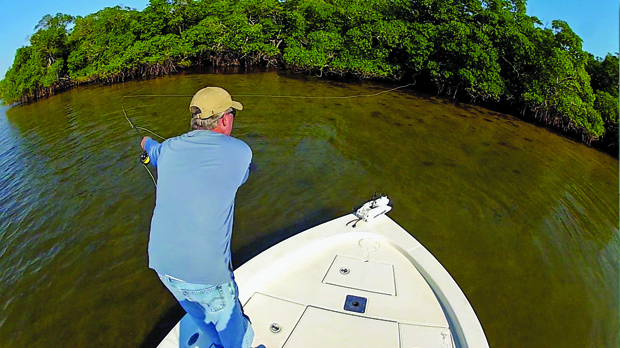August 29, 2016
By Mike Conner
Try this current-countering cast to catch more fish.
 After stopping rod on forward stroke, author extends rod hand upcurrent to lay line on water above the fly.
After stopping rod on forward stroke, author extends rod hand upcurrent to lay line on water above the fly.
I grew up fishing tight, winding Everglades creeks and brackish canals for snook, tarpon and bass. Tucking a bug popper or streamer under overhanging branches is tricky, but such fly fishing is best when tidal current is present. And that makes fly presentation an even tougher challenge. Current running parallel to shore tugs at your floating line and can pull your fly out of the cover prematurely. Where shoreline cover such as fallen limbs are common, the current may be much weaker close in, in comparison to open water 6 or more feet from shore. So much of your line “midstream” is carried faster than the tip of the line, leader and fly. A big belly forms, and even if a fish is able to chase your bug down and grab it, setting the hook is problematic.
So, how to decrease the drag on your line and keep your fly in the hot zone longer? Use the reach cast—a standard cast used by trout anglers on streams and rivers.
This “current-countering” cast is ideal whether you're casting from the opposite bank on a narrow creek, or from a stationary boat on bigger water. It helps around docks, and is useful when surf fly fishing, too, where waves or longshore current tends to sweep your fly down the beach too quickly.
If you cast straight to the target, the majority of your line sweeps downcurrent faster than your fly, and a belly forms, pulling your leader and fly out of the strike zone.
Put It into Practice
Cast as you normally would to a target along the bank. The instant you stop your rod on the forward stroke, extend your rod hand up-current on a plane parallel to the water. This lays your line on the water above your fly, and will not affect your accuracy because your fly always goes in the direction in which you stop your rodtip. This is easiest when you have close to the exact length of line outside your rodtip you need to reach the bank. However, you can definitely shoot additional line if needed, and the reach motion will not affect
the shoot.
Right-handed casters dealing with current flowing right-to-left will reach right. Left-to-right current calls for the opposite, reaching left, with the arm and hand ending up across the chest. Left-handed casters in a right-to-left current would reach across the body, and with a left-to-right current, would reach hard left. Once your fly line touches down, you immediately point the rod back at the fly and begin fishing it. You'll discover that the fly will indeed track right at the rodtip as you strip it.
Dock fishing, day or night, is an ideal scenario for this cast, too, when you're presenting flies to the end or “T” of a dock where current rips along perpendicular to the structure. When you tuck a fly well under the dock, reaching upcurrent buys you a few extra seconds to keep the fly from getting yanked out of the shadows too soon.
Sinking Line Applications
Unless you are fly fishing a pancake-flat surf, the reach is useful and even with a slow-sinking line. If you encounter a strong longshore current, it is a big help to lay your line upcurrent. But even a normal shore break, with perhaps knee-high waves, tends to wash your line up onto dry sand too quickly. What I do in this situation (and I'm normally casting at an angle to the beach) is reach hard “seaward” to put my line as far out as I can. I'm left-handed and if I am casting at an angle to my left, I will reach to the right, across my chest.
When casting to my right, I reach hard away from my body. Even if the wind direction demands that I back-hand cast primarily (in my case a north to northeast wind on Atlantic beaches where I fish) I can put a reach into a cast, though it's a bit awkward at first. Here's a tip: To decrease the effect that surf current has on your fly, use weighted patterns. They tend to “weight down” your line and leader a little.
Lastly, a 9-foot or even longer rod is a better reach casting tool than shorter rods. The extra length increases the angle of your line above the fly a little. FS
First published Florida Sportsman August 2015

